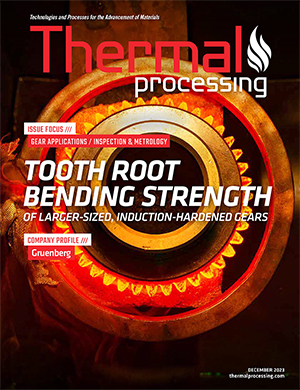
No one knows everything. Nor will anyone ever obtain all the knowledge in the world. Sometimes what happens, though, is we learn something and then decide we are now experts in that area. This blind spot can mislead us, a phenomenon known as the Dunning-Kruger effect. This effect is when a person knows very little about something yet has great confidence in their expertise.
This has happened to me in solving complex heat-treat problems over the years, and has humbled me in my learning journey. Simplifying alloy systems to binary eutectic phase diagrams makes the thought process relatively simple when considering solidus and solvus lines for solution and age temperatures. But it can’t solve every heat-treat problem. To overcome this situation, one needs to continually ask questions, be honest with themselves about their knowledge base, and get genuine feedback (not flattery for how awesome they always are).
It is more challenging to read the literature on how other alloying elements can create other phases, change the solidification temperatures, or even impact diffusion mechanisms than it is to rely on what we already know. However, to keep that limited perspective and not look beyond our current knowledge will not result in proper heat treat. It’s easy to stick with what we know and the knowledge familiar to us.
Sometimes, working to expand our knowledge base is a daunting prospect. That fear in the employee to look inward to reflect on their current state of knowledge is similar to being on top of the mountain; they don’t want to come down. But by keeping their head always pointing up, they can’t see where they are going as they don’t look down at what they are stepping on. That can translate to overlooking a failed metallographic test here or missed cycle there. Without continually studying the proper literature, being honest in our assessment of our true knowledge base, and receiving appropriate feedback, the proper heat-treat cycle does not get performed.
Running a slow ramp rate past a solvus temperature based upon the binary phase diagram can get you in the ballpark of the correct heat treat. Metallographic results can demonstrate effective ramp rates, solution temperatures, and times. This is genuine feedback. If the results are not passing, then consideration of performing calorimetry testing and studying the effects of alloying elements and their interactions on the system is needed.
However, it takes a certain sort of bravery to embark down a path of knowledge we don’t know. Through the “valley of despair,” confidence becomes low when we begin to realize how little we know about something — electron vacancy calculations for potential phase formation, slip planes of metallic structures, diffusion mechanisms, or thermodynamic considerations of phonons, for example. These are all potential phenomena to consider at elevated temperatures and times and manufacturing of metal alloys. All are worthy of their own lifetime of exploration in understanding.

This isn’t to discourage someone to keep learning. This is the blind spot we have, the area we cannot see because we are too afraid to look. Instead of being blind to it, the more we keep an open mind, and keep learning fun and exploratory with constructive feedback, we will begin to acquire the toolbox of questions to ask. It isn’t necessarily about what we know; it often comes down to what types of questions we can ask to figure out what we don’t know so we can solve a given problem.
This phenomenon can also apply beyond just material science calculations for heat-treat cycles. It can extend to other facets of the employee role — employees who are managers, supervisors, or heat-treat operators all have avenues of responsibility that benefit from continuing to widen their knowledge base. The fact that no one is perfect nor can ever truly know everything leaves us at the mercy of the Dunning-Kruger effect if left unchecked.
Peter’s Principle is the condition when an employee “rises to the level of their incompetence.” That is, an individual can begin as a heat-treat operator and be very skilled. However, over the years this employee gets a promotion and now is the heat-treat supervisor. The skills of being the heat-treat operator are not always transferable to that of being the supervisor (thus reaching the level where the employee is not competent). The lack of developing the skills to be an effective supervisor or manager results from the Dunning-Kruger effect. Because the success of this employee was based upon their heat-treat experience as an operator, there is potential belief that what they were doing then will now work as they supervise. But just as in the example of investigating beyond the simple binary phase diagram for defining heat-treat cycles, more work is needed to develop the social skills necessary for managing other employees in order to be a successful supervisor.
An operator can probably talk to the furnace to make it work, but talking to other employees as a supervisor or manager or even as a leader takes a different type of communication skill. To overcome this blind spot, the same need to ask questions, assess one’s personal knowledge, and obtain feedback is required.
Asking questions in the heat-treat department is critical to a successful process. But beyond asking the questions of whether a cycle properly solutions or hardens or tempers, questions around personnel motivation, work ethic, and even emotional intelligence are needed with the step up from operator to manager. Thinking that heat treating is purely technical is a critical mistake for any employee dealing with human relations.
Therefore, it is critical to assess one’s knowledge of their own psychological image. What motivates a particular employee? This may not be the same for them as it is for you. Some people work for a paycheck to support a family. Others don’t have families and simply love to work. Others have a particular enthusiasm for certain occupations. Knowing what motivates employees is critical to steering the heat-treat facility in the right direction for overall success beyond a successful physical technique.
Feedback with individuals can be measured by overall enjoyment of the job or willingness to perform a particular function. This feedback is like metallographic reports based upon time and temperature in a furnace. If threats are required to motivate employees, that manager is lacking the bravery to understand what motivates themselves. Turning up the temperature of the furnace doesn’t always solve the problems in heat treat.
Instead, we must turn inward; we need to put the microscope on ourselves. Again, it is not a matter of what we know. The measure is really the way we approach something and can ask questions, get appropriate feedback, and properly assess how we quantify our knowledge so we can gain the information required to get the results we seek.

























